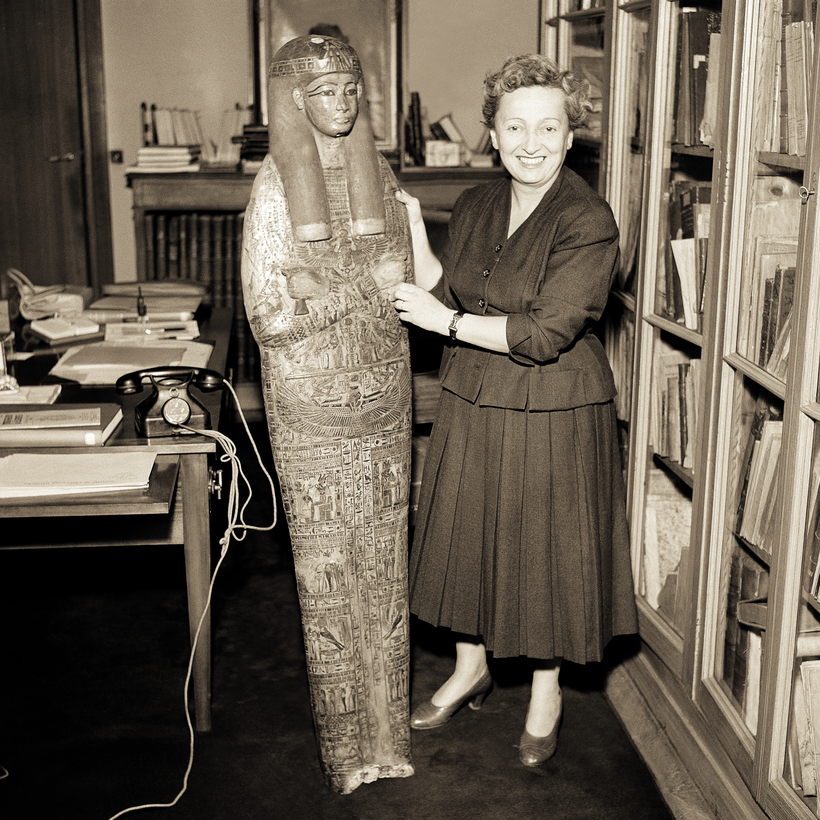Sometime in 1961, Jacqueline Kennedy wrote her husband, the young new president of the United States, about the unprecedented archaeological race underway in Egypt’s Nubia region. The mission: to save the towering Abu Simbel temples and their four colossal statues of Rameses II. The ticking clock: the Nile waters soon to be unleashed by the opening of President Gamal Abdel Nasser’s Aswan High Dam. Her memo concluded, poignantly, “If I were a young man, I would be an archaeologist and go to that region.”
Little did she know that the person overseeing the massive rescue operations was a woman: Christiane Desroches-Noblecourt. In her early 40s and already at work in Egypt for more than 20 years, the Parisian-born archaeologist had, with sharply honed persistence, managed to rise to the top of a lofty, profoundly misogynist profession, entering the field when, in France, as in most countries, it was a male-only preserve. Desroches-Noblecourt would remain involved and enthralled almost until the day she died, at 97 in 2011, the recipient of the Grand Cross of the Légion d’Honneur, a best-selling author, and a lover of the dynastic color lapis-lazuli blue.

Lynne Olson’s Empress of the Nile: The Daredevil Archaeologist Who Saved Egypt’s Ancient Temples from Destruction follows Desroches-Noblecourt every step along the way. And I mean every step. Deeply researched, it contains in its many detours and side trips a certain amount of historical T.M.I. There’s also its police-siren subtitle, and opening attempts to paint Desroches-Noblecourt as a “real life female version of Indiana Jones,” which luckily peter out after a while.
Olson’s subject doesn’t need Hollywood superlatives. For black-tie value alone, without Desroches-Noblecourt there would be no Temple of Dendur at the Met. (By the way, in case you thought it was a pharaoh’s monument, it was actually built on Egyptian soil at the behest of Caesar Augustus, emperor of Rome.)
Born into an upper-class family that encouraged education and intellectual curiosity in its only daughter, Desroches (we’ll get to the Noblecourt part in a bit) defied traditional expectations by graduating from the Sorbonne and training at the Louvre.
Her maiden voyage to Egypt, in 1937, was in the luxurious style to which her class was accustomed. At the captain’s table aboard the S.S. Champollion, she was seated with the exiled Haile Selassie and the Aga Khan, an eventual patron. At her first dig, in the so-called Valley of the Kings, near the village of Deir el-Medina, she proved game for hardships, occupying an empty chamber in one of the tombs, making do without electricity or running water.
She bucked an Egyptology that, as Olson puts it, remained “the handmaiden of imperialism” and excluded Egyptians themselves from its ranks. Against that grain, Desroches learned Arabic, mingled with Cairo’s elite, and treated workers on her digs with respect and a belief that their lives illuminated those of their ancestors, the servants and laborers depicted in ancient funerary reliefs.
This served her especially well once Egypt declared its sovereign independence from Britain under Nasser, who had less than little love for the West. During the Second World War, Desroches joined a Resistance network drawn from the museum and art worlds. Arrested by the Gestapo, she showed her supercilious side, responding to the officers interrogating her almost as haughtily as she would upbraid Aristotle Onassis for poor manners the first time they met.
All of five feet tall, she was known to tell six-foot-five-inch Charles de Gaulle a thing or two. Like a suit of armor, her hair was always carefully done, and around her neck she wore icy strands of pearls. In photos from excavation sites, she looks Greta Garbo–chic.
In 1942, she married André Noblecourt, an engineer, an occurrence Olson dispenses with in barely half a page: Desroches-Noblecourt made it clear to her husband that marriage and motherhood—they had one son—would have to take a back seat to her career.

The campaign to preserve the Abu Simbel temples by disassembling the Notre Dame–size structures and reconstituting them on higher ground was international in scope. Known as the largest dig in history, it was one of Desroches-Noblecourt’s crowning achievements, although far from her last.
Her influence on museum-going and cultural consumption, generally through blockbuster shows, was enormous—the ticket holders’ line for the Met leg of the 1975 exhibition “Treasures of Tutankhamun,” which reached New York in 1978, stretched down Fifth Avenue for 23 blocks, and the “Rameses le Grand” exhibition, which Desroches-Noblecourt curated in 1976, was larger yet.
Be the kingdoms of the pharaohs and their shiny gold as they may, Desroches-Noblecourt helped bring equally significant intangibles to light. Join the tour she gave President and Madame de Gaulle at the Petit Palais in 1975, where the boy king’s blazing funeral mask rested in state, and you’ll learn that in the Egyptians’ image of the lotus, symbolizing the daily rebirth of the sun out of the night, lies the concept of the Eucharist in the form of the circular host representing the body and resurrection of Christ.
Contemplating a book about the controversial Amenhotep IV, rejected as a dictator and heretic by most historians, Desroches-Noblecourt saw a renegade who established monotheistic worship, with implications for millennia to come.
She made strides for women and scholarship and implacable independence. She was, in the end, well named. Desroches, as in rocks. You can figure out the Noblecourt part.

Celia McGee is the editor at large for Avenue magazine


